Barely four months after the government justified undoing of Article 370 by asserting that Jammu and Kashmir’s backwardness was rooted in its special status, Niti Aayog’s just released SDG India Index revealed that the erstwhile state was doing better than many other states, reports Masood Hussain
 “Jammu and Kashmir didn’t develop at the pace it rightly deserved, but its people will have a brighter future now,” Prime Minister Narendra Modi said, a day after the erstwhile state’s special status was binned on August 5. “The 1.5 crore people of Jammu and Kashmir did not even benefit from education laws drafted for the entire nation. Children in Jammu and Kashmir didn’t even get the right to education. What was their crime? Some rights to the girls were not implemented in J&K, which they had in other parts of the State. Why?”
“Jammu and Kashmir didn’t develop at the pace it rightly deserved, but its people will have a brighter future now,” Prime Minister Narendra Modi said, a day after the erstwhile state’s special status was binned on August 5. “The 1.5 crore people of Jammu and Kashmir did not even benefit from education laws drafted for the entire nation. Children in Jammu and Kashmir didn’t even get the right to education. What was their crime? Some rights to the girls were not implemented in J&K, which they had in other parts of the State. Why?”
In the just-released Sustainable Development Goals (SDGs) that Niti Aayog jointly published with the United Nations – as part of India’s global commitment to better living, there is enough of hard statistics that negates the claims made by the BJPs top brass in wake of the abrogation of the Article 370. Using a diversity of data on states and sectors, the exercise created 17 SDGs for the use of policy making in the next one decade. While doing this, it identified 169 targets and 306 national indicators. Of the 17 SDGs, the Aayog constructed the SDG India Index spanning across 13 of the 17 SDGs. The index, an aggregate measure, tracks the progress of all the states and UTs on a set of 62 priority indicators.
India’s SDG index score stands at 57. Jammu and Kashmir stand at No 20 slot with SDG index score of 53. The index is based on data that the Aayog researchers have used for different time periods. On various parameters, Jammu and Kashmir is better than many best states. There is a possibility, however, that fresh data and fair treatment to other parameters, not considered by the survey, could improve Jammu and Kashmir’s tally.
States have been divided into four categories: achievers (100 per cent of target set for 2030), front runners (for 65-99 per cent achievement), performers (50 to 64 per cent) and aspirants (0-49 per cent). Jammu and Kashmir tops in at least eight parameters. Of the 13 SDGs, Jammu and Kashmir fall among front runner states in 3 SDGs, shares performer states status for six SDGs and lags behind with aspirant states for four remaining SDGs.
Here is where the SDG puts Jammu and Kashmir on 13 key areas:
NO POVERTY
Tendulkar Committee estimates that 21.92 per cent people in India lived below the poverty line in 2011-12. India is working to reduce it to 10.35 per cent by 2030. Jammu and Kashmir’s BPL population is 10.35 per cent (data 2011-12).
Jammu and Kashmir is above the ladder with an index score of 61 against the national average of 54. The score is based on a number of parameters, in some of which Jammu and Kashmir is the best but in certain areas, it has under performed. The score is based on five different parameters.

For instance, Jammu and Kashmir have only 4.20 per cent households having one of its members covered for health insurance (data 2015-16). This is because the health insurance trend is either missing on the ground or is restricted to a section of the government employees and individuals working for the MNCs. On this front Jammu and Kashmir falls lowest in the ladder. Off late, however, the Ayushman Bharat has started creating some impact on the ground.
The other parameter is the percentage of people who sought “employment” under MNREGA (2017-18) and actually got it. Jammu and Kashmir has scored better: 88.79. This data, however, is highly questionable because the rural development set-up in the erstwhile state has tweaked with the implementation part of the scheme to keep it running.
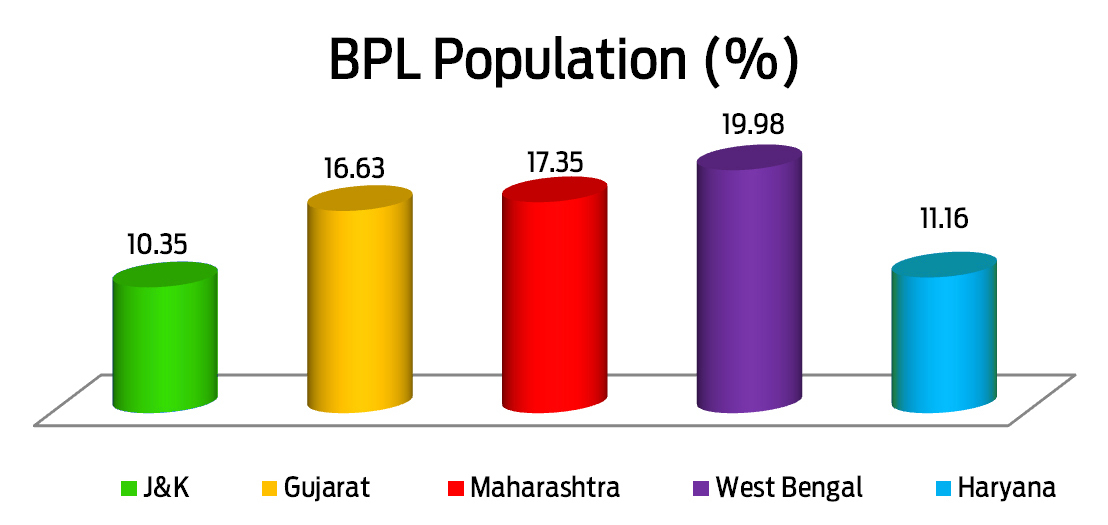
On the parameter about the percentage of the eligible population seeking benefits under maternity benefits, Jammu and Kashmir has done better: 54 per cent (2015-16).
Interestingly, in the parameter pertaining to the houseless population (number per 10,000 households), the NitiAyog says 12.33 (2011-12) are without shelter. On this count, 22 states and UTs have performed better. National average is 10 in 10, 000 households. However, the houseless population in Jammu and Kashmir mentioned in the survey may require a re-check because quite a few are houseless in Jammu and Kashmir.
ZERO HUNGER
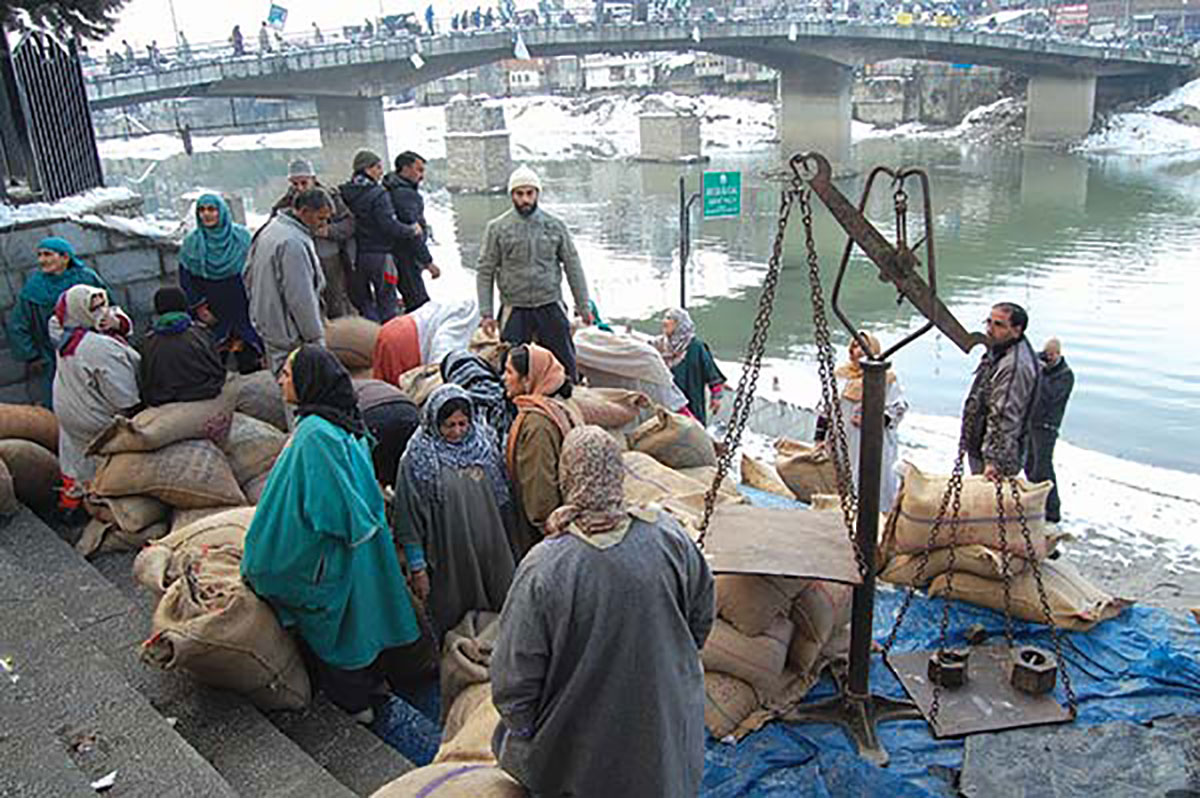
In order to capture the state of hunger and the allied issues like malnutrition, anaemia and linking it with the agriculture production, the survey has created an index in which Jammu and Kashmir falls at No 9 position with a score of 60.
The index score is based on the evaluation for four parameters. The first parameter is ‘the ratio of rural households covered under public distribution system to rural households where the monthly income of highest-earning member is less than Rs 5000’. Jammu and Kashmir’s index score is 0.94 (2011-12).
The second parameter is the percentage of children under five years of age who are stunted. Jammu and Kashmir is better at 27.40 against the national average of 38.40 percent (2015-16).
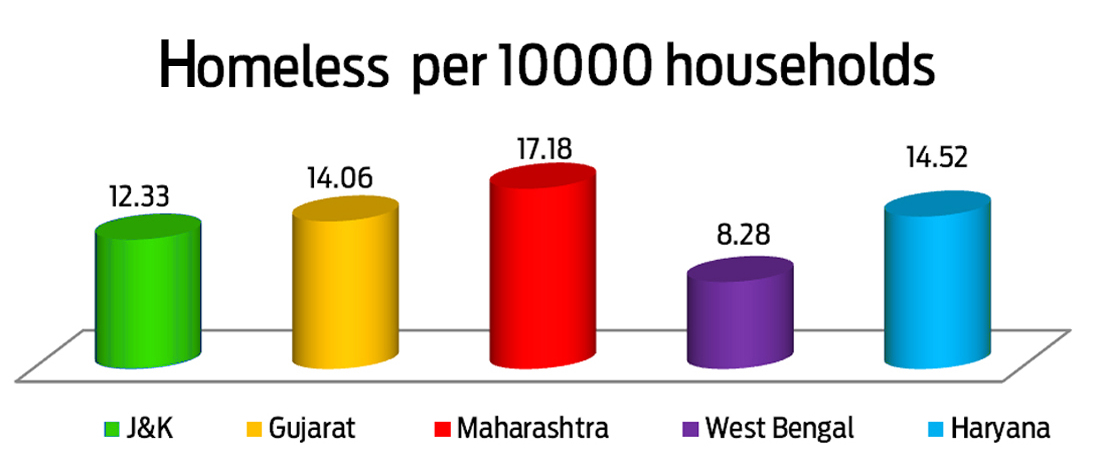
Percentage of the female anemic population is the third parameter. Against the national average of 50.30 per cent, Jammu and Kashmir has 38.10 per cent (2015-16) only.
The annual per hector yield is the last parameter. The national average is 2509.22 kgs per hector. Jammu and Kashmir produces 1966.10 kgs per hector (2015-16). But the survey seemingly has ignored two key factors on this count: Most of the Jammu and Kashmir including Ladakh grows only one crop a year; Most of Kashmir has ceased to grow any cereals as the rice fields have been converted into apple orchards.
GOOD HEALTH

The state of health and well being has been decided on the basis of five parameters. The national average index score is 52. Jammu and Kashmir has got a score of 53 for a No 14 position in the overall ranking, two notches more than Gujarat.
In the first parameter – maternal mortality ratio (deaths per lakh of berths), Jammu and Kashmir has no data. The second parameter is mortality under five years of age in 1000 live births. Against the national average of 50, Jammu and Kashmir has 38 (2014-16).
Immunization in (12-23 months) children is the third parameter and 62 is the national average percentage. Jammu and Kashmir has 75.10 (2015-16).
Detection of Tuberculosis per one lakh population is another parameter and the national average is 138.33. Jammu and Kashmir has 74 (2016-17), the lowest in India; only next to 70 is Lakshadweep.
The last parameter is the presence of health workers (doctors, nurses and allied workers) per one lakh population. The national average is 220. Jammu and Kashmir has only 29.80 (2-15-16), the second-lowest in India.
Ideally, a geographic unit offering better health care despite the lowest health workers should have fetched it a better score.
EDUCATION
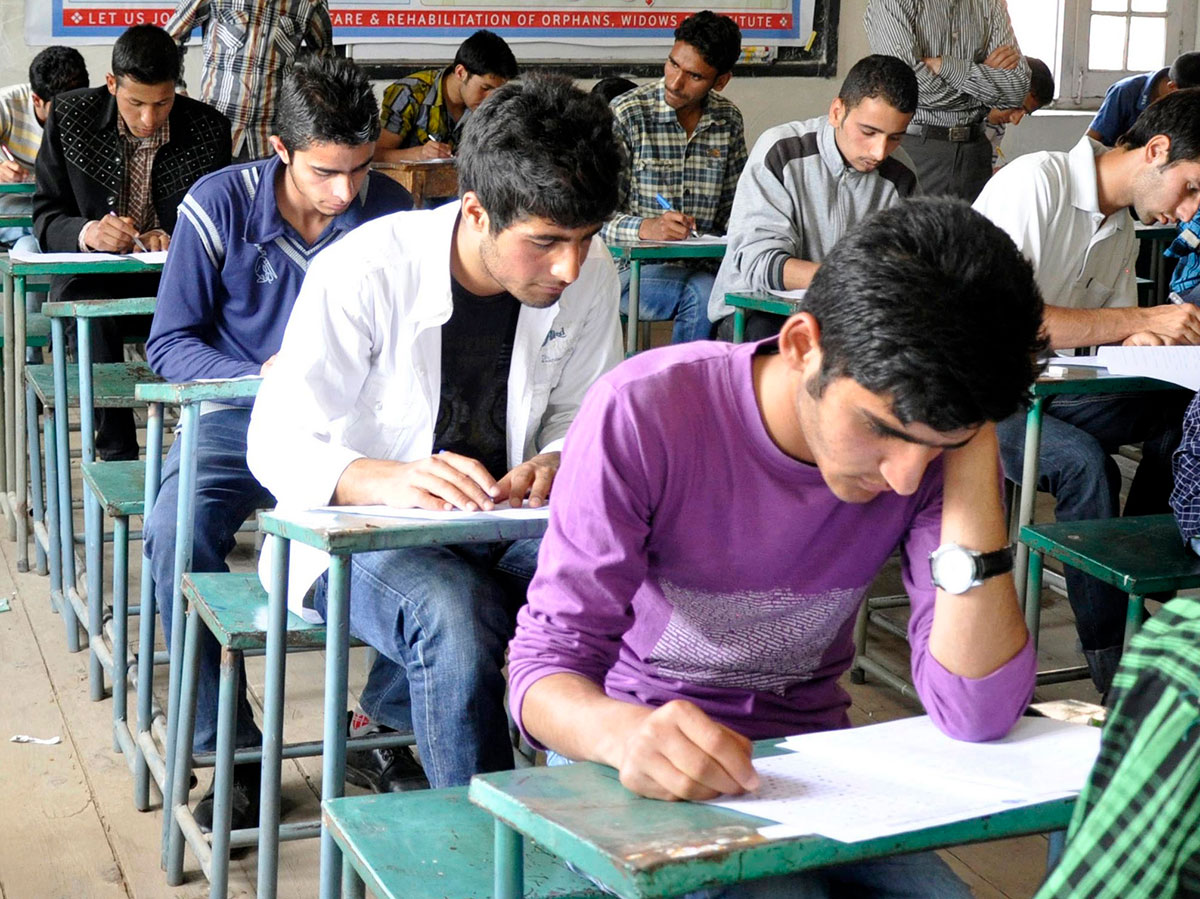
Evaluated on the basis of seven different parameters, the average national score is 58. Jammu and Kashmir is below the ladder at No 21 position with a score of 51.
Parameter one is the net enrollment ratio up to the tenth standard. Against the national average of 75.83, Jammu and Kashmir has 57.22 per cent (2016-17).
The second parameter is the percentage correct response on learning outcomes in language, mathematics and EVMs for the fifth primary. The national average for this parameter is 54.69 per cent and Jammu and Kashmir has 54.33 per cent (2016-17).
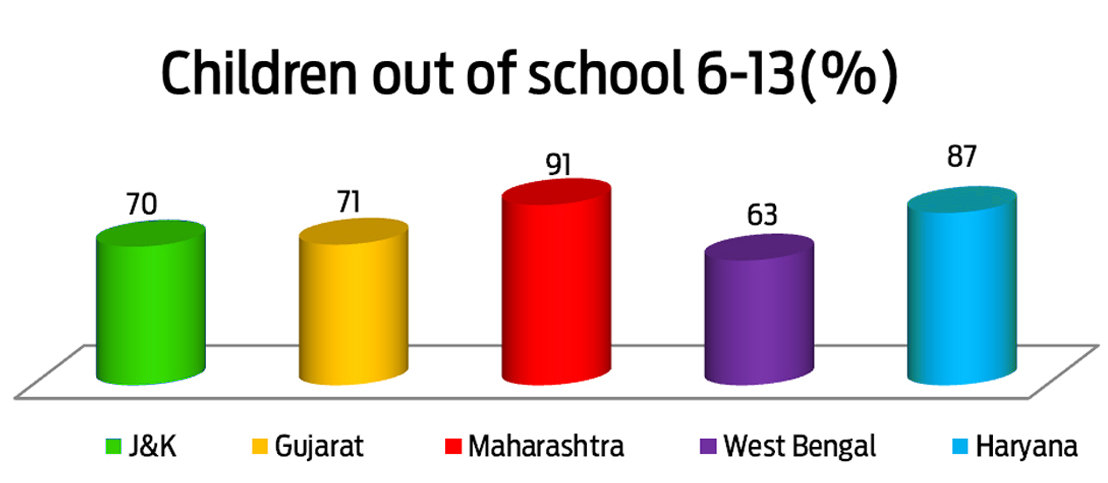
Third parameter is the percentage correct response on learning outcomes in language, mathematics, science and social sciences for the eighth class. Against the national average of 44.58 per cent, Jammu and Kashmir has 38 per cent (2016-17).
The fourth parameter is the percentage of children in the 6-13 age group who are out of school. Against the national average of 2.97 per cent, Jammu and Kashmir has 2.04 per cent (2014).

The average percentage dropout rate at the secondary level is another parameter. Against the national average is 17.06 per cent, Jammu and Kashmir has 17.28 per cent (2015-16).
Percentage of professionally qualified teachers is yet another parameter and the national average is 81.15 per cent. In case of Jammu and Kashmir, it is 56.39 per cent (2016-17).
Pupil-teacher ratio at the elementary and secondary level (less or equal to 30) is yet another parameter. Against the national average of 70.43 per cent, Jammu and Kashmir has 96.07 per cent (2016-17).
GENDER EQUALITY
Assessed on the basis of a set of six parameters, the national average score is 36. Jammu and Kashmir falls at No 15 slot with a score of 39, at least nine notches up from Gujarat.

Against the national average sex ratio of 898, Jammu and Kashmir has 906 (2014-16).
The average female to male ratio of average salaried or wage employees is a key parameter. The national average is 0.70. Jammu and Kashmir has 0.73 (2011-12).
Percentage of ever-married women in 15-49 age group who had no experience of spouse violence is another parameter. The national average is 33 per cent. In Jammu and Kashmir, this parameter is 13.90 per cent, one of the lowest in India (2015-16).
Women winning the state assembly polls are another indicator. Against the national average of 8.7 per cent, the Jammu and Kashmir has only 2.30 per cent (2016-17). This is rooted more in the cultural value system rather than inequality.
Ratio of female labour forces participation to male participation is yet another indicator. The national average is 0.32 per cent. In Jammu and Kashmir, it is 0.16 per cent, one of the lowest in India. (2015-16)
Use of modern methods of family planning among women has a national average of 53.55 per cent. In case of Jammu and Kashmir, it is at 57.30 per cent (2015-16).
CLEAN WATER

Assessed on basis of five different parameters, the clean water and sanitation indicator has a national average score of 63. Jammu and Kashmir falls at No 21 position with a score of 52.
Against the national average of 71.60 per cent population having safe and adequate drinking water in rural areas, Jammu and Kashmir has 60.15 per cent (2018).
Percentage of rural households owning a toilet is a key parameter. The national average is 82.72 per cent. In a Jammu and Kashmir only 72.39 per cent own a toilet at home (2018).
Against a national average of 31.95 per cent districts having been declared open defecation free, Jammu and Kashmir has not even a single district to claim that honour as on March 2018.
Percentage installation of sewage treatment facility to the overall sewage produced is another parameter. The national average is 37.58 per cent. Jammu and Kashmir has slightly a better percentage: 48.40 per cent (2016).
The last and vital parameter is the percentage withdrawal of groundwater against the annual availability. The national average is 61.53 per cent. Jammu and Kashmir is 24.48 per cent (2012-13), which means Jammu and Kashmir is least disturbing the water table in comparison to other states.
CLEAN ENERGY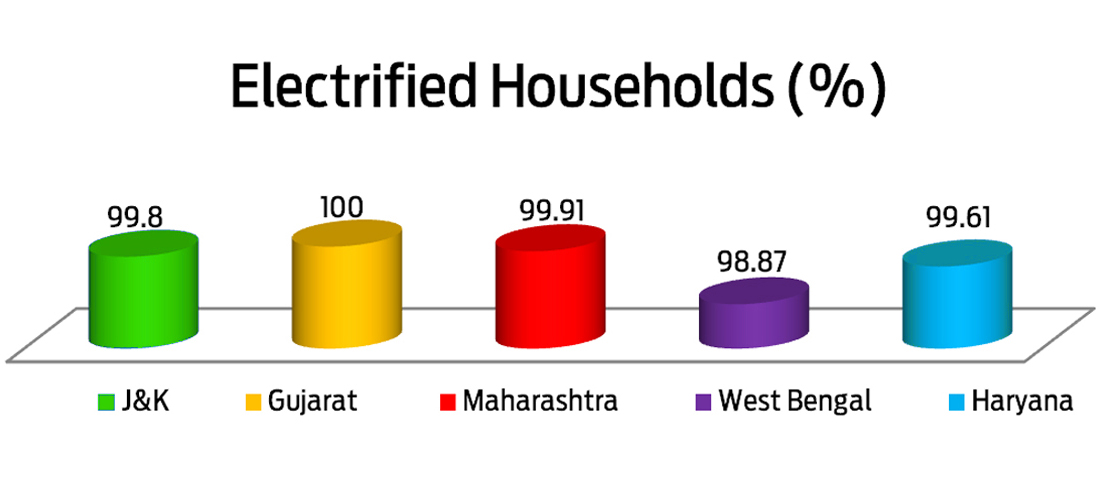
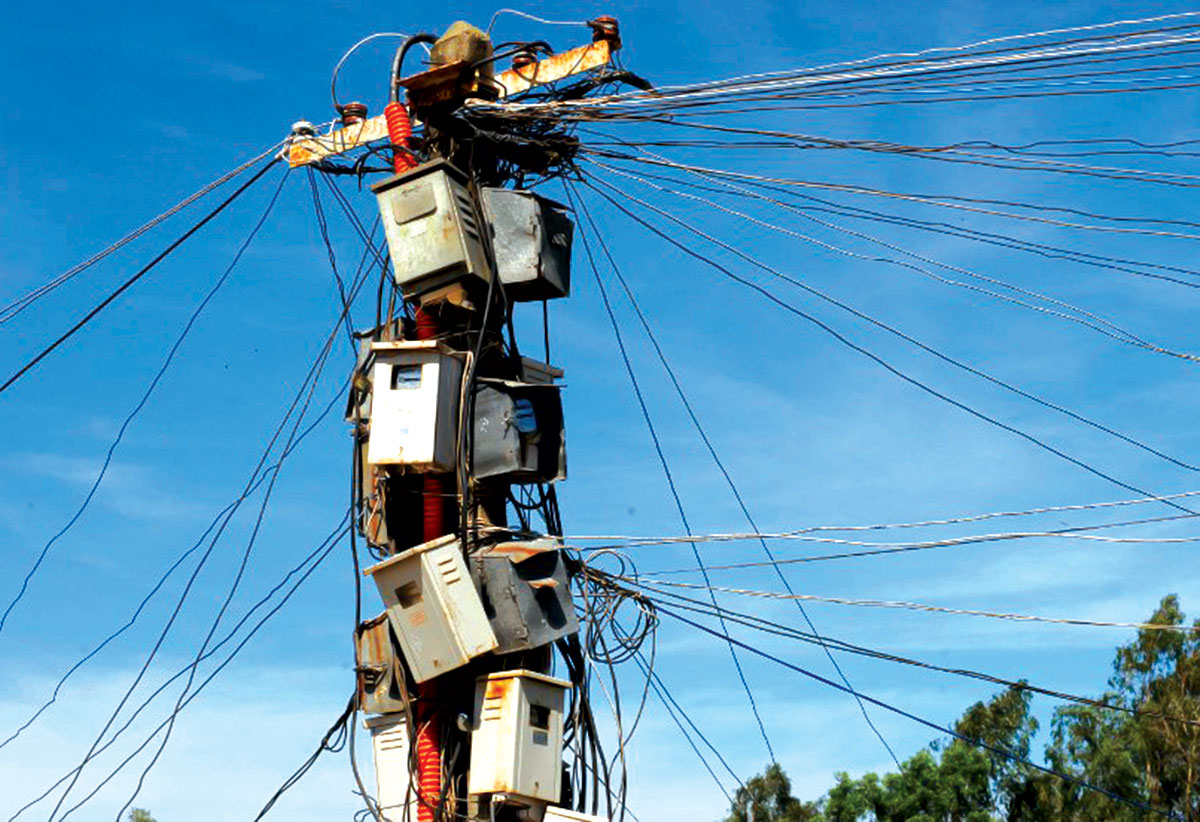
Evaluated on basis of three parameters, the national average score is 51. Jammu and Kashmir falls at No 14 with a score of 58. Against the national average of 94.57 per cent electrified households, Jammu and Kashmir has 99.80 per cent (2018). Percentage of households using clean cooking fuel across India is 43.80 per cent, and in Jammu and Kashmir, it is 57.60 per cent (2015-16). The national average of percentage of renewable share of installed generating capacity is 17.15 per cent and in case of Jammu and Kashmir, it is 10.19 per cent (2017).
ECONOMIC GROWTH

This indicator arrived on the basis of four different parameters. The average national score is 65. Jammu and Kashmir falls at No 27 with a paltry score of 43.
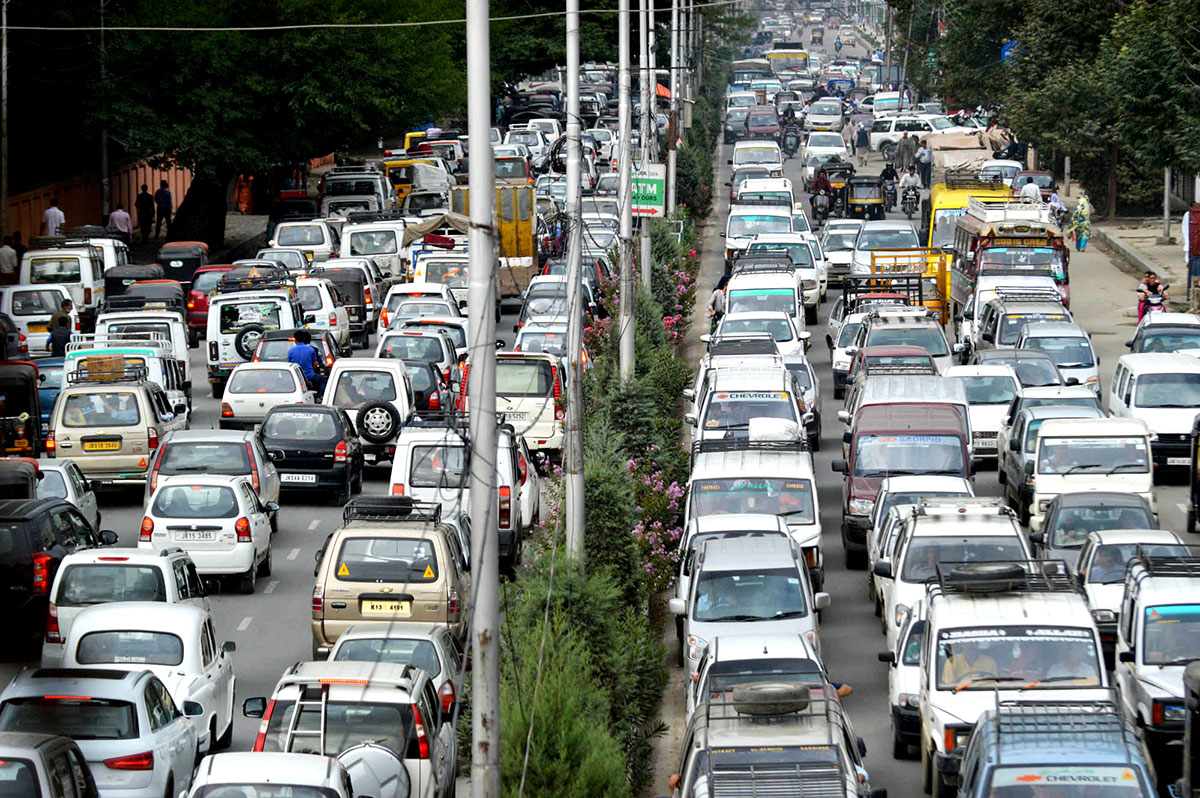 Average per capita growth rate on constant prices is one parameter. Against the national average of 6.50 per cent, Jammu and Kashmir has 14.45 per cent (2017-18), the highest in India.
Average per capita growth rate on constant prices is one parameter. Against the national average of 6.50 per cent, Jammu and Kashmir has 14.45 per cent (2017-18), the highest in India.
The unemployment rate of boys and girls per 1000 is a key parameter. Against the national average of 63.50, it is 154 in Jammu and Kashmir (2015-16).
In India, 99.99 per cent households have a bank account and in Jammu and Kashmir, it is only 99.71 per cent (2018).
By an average, there are 16.84 ATMs for one lakh population across India. In Jammu and Kashmir it is 18 (2018).
INDUSTRY AND INFRA
Based on four simple parameters, the overall national score is 44. Jammu and Kashmir is at slot 17 with an index score of 35. Percentage of targeted habitations connected by all-weather PMGSY roads has a national average of 47.38 per cent but in case of Jammu and Kashmir, it is 29.75 only (2017-18).
The average number of cell phones per 100 people is 82.97 percent and this parameter in Jammu and Kashmir is 92.48 per cent (2016-17). In India, 33.47 percent, for every 100, use interne. In Jammu and Kashmir, it is 35.71 (2017). Against the national average of 42.43 per cent of Gram Panchayat’s covered under Bharat Net, it is only 4.90 percent in Jammu and Kashmir (2016-17).
REDUCED INEQUALITIES

Again, based on five different parameters, the survey has reached to a national average index of 71. Jammu and Kashmir falls at No 21 position with the same average.
For urban and rural inequalities, the survey has used Palma ratio (a measure of inequality, which is the ratio of the richest 10 per cent of the population’s share of gross national income (GNI) divided by the poorest 40 per cent’s share) to understand the expenditure dynamics. In urban India, it has found the 10 per cent of the well to do households consume1.41 times of the net consumption of the 40 per cent households falling in the lower economic strata. In Jammu and Kashmir, however, it is slightly lesser: 1.05 rimes. In the rural areas, the average national average is that top 10 per cent households consume 0.92 times of the 40 per cent of the population in lower economic stratum. For Jammu and Kashmir, this is at 0.75. (2011)
An important parameter is the ratio of transgender labour participation rate to male labour force, which, on all India basis is 0.64. In Jammu and Kashmir, only 0.25 trans-genders (2015-16) participate in the labour market in comparison to one male.
The survey lacks any details about the percentage expenditure of the specific sub plans for Schedules Castes and the Scheduled Tribes.
SUSTAINABLE COMMUNITIES
 This important indicator details the basic requirement for the urban spaces including housing and the waste management. On the basis of four parameters, the overall average across India for this indicator has been assessed at 39. Goa tops the list. Jammu and Kashmir falls at the bottom of the rating ladder at No 29 with a score of 23.
This important indicator details the basic requirement for the urban spaces including housing and the waste management. On the basis of four parameters, the overall average across India for this indicator has been assessed at 39. Goa tops the list. Jammu and Kashmir falls at the bottom of the rating ladder at No 29 with a score of 23.
Building new houses under the centrally sponsored Pradhan Mantri Awas Yojana (PMAY) is the first indicator. Against a target of 100 per cent, the achievement at the national level is 3.32 per cent. Jammu and Kashmir’s achievement is only 0.22 per cent (2018).
The second major parameter is the percentage of urban population living in the slums. Against the national average of 5.41 per cent, Jammu and Kashmir has 5.28 per cent urban population living in slums (2011). This figure is shocking because the percentage of the houseless population is quite less. There is, however, part of the seasonal labour, some floating populations and refugees (in Jammu) who live in slums.
Percentage of wards with 100 per cent door-to-door waste collection is another parameter. The survey suggests that 100 per cent waste is collected from door to door in 73.58 per cent wards. In Jammu and Kashmir, it is happening in only 35.45 per cent wards (2018).
Against the national average of 24.80 per cent waste being processed, Jammu and Kashmir is at the extreme bottom of the list where only one per cent waste generated is being treated (2018).
LIFE ON LAND

One of the crucial indicators, the survey has made an assessment on the basis of four different factors to reach to an average national score of 90. Jammu and Kashmir falls at No 20 slot with a score of 73.
The first parameter is the traditional percentage of land covered by the forests. Against a national average of 21.54 per cent, Jammu and Kashmir has only 10.46 per cent forest cover (2017).
Second major parameter is the change in water bodies within the forests in a decade. Against the national average of 18.24 per cent, Jammu and Kashmir has 7.49 per cent. The other parameter is the net change in the forest area in two years ending 2017. Against the national average of 0.21 per cent, Jammu and Kashmir’s achievement is 0.11 per cent.
STRONG INSTITUTIONS
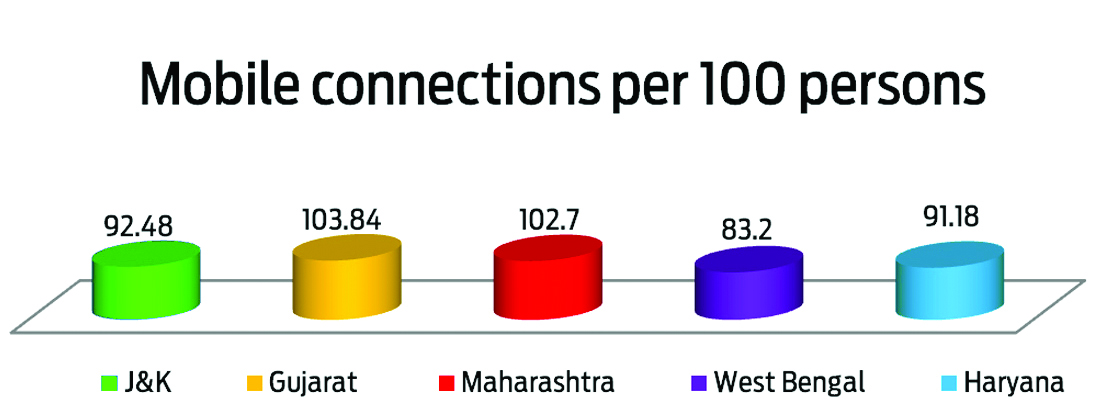
Since sustainable development has direct linkage with peace, security, effective governance and the rule of law, the survey has created a national average score of 71 for peace justice and strong institutions. Jammu and Kashmir falls at No 18 slot with a score of 69. This might have phenomenally changed after August 5, however.
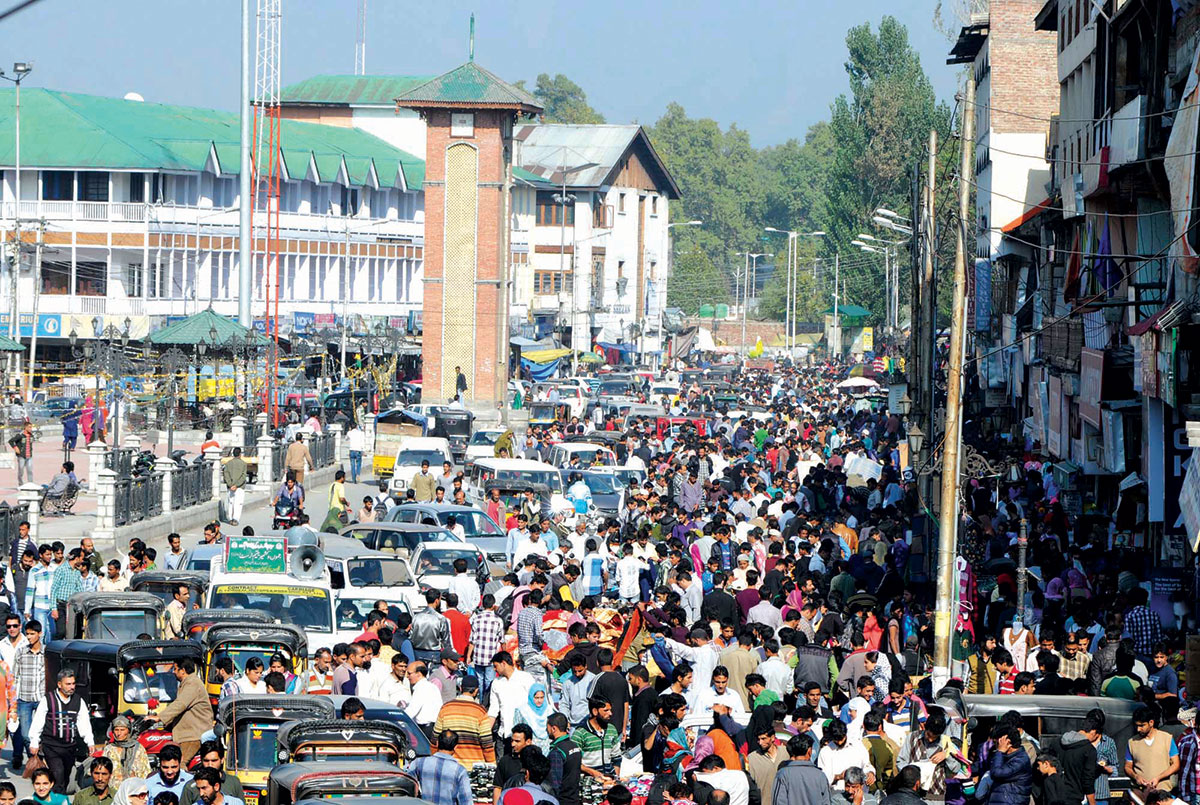
This assessment is based on six different parameters. Against the national average of 2.40 murders per one lakh population, Jammu and Kashmir has only 1.10 (2015-16). The survey suggests the target for this parameter to be at 1.20 by 2030.
Against the national average score of 24 for cognisable offences against children in one lakh population, Jammu and Kashmir has one of the lowest in India – 4.90 (2015-16).

Against the national average of 12.83 courts available for one million people, Jammu and Kashmir has only 9.52 (2017).

The all India average of corruption crimes per crore of the population is 34.01. In Jammu and Kashmir, this figure is at 75.51 (2015-16), perhaps one of the highest in India.
Registration of births is a major indicator. Against 88.30 per cent of births being registered in India, it is only 76.30 per cent in Jammu and Kashmir (2015).
Aadhar is yet another parameter. Against 89.50 per cent populatkashmir eduion covered by the Aadhar across India, in Jammu and Kashmir it is only 73.10 per cent (2018).

